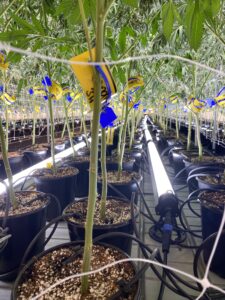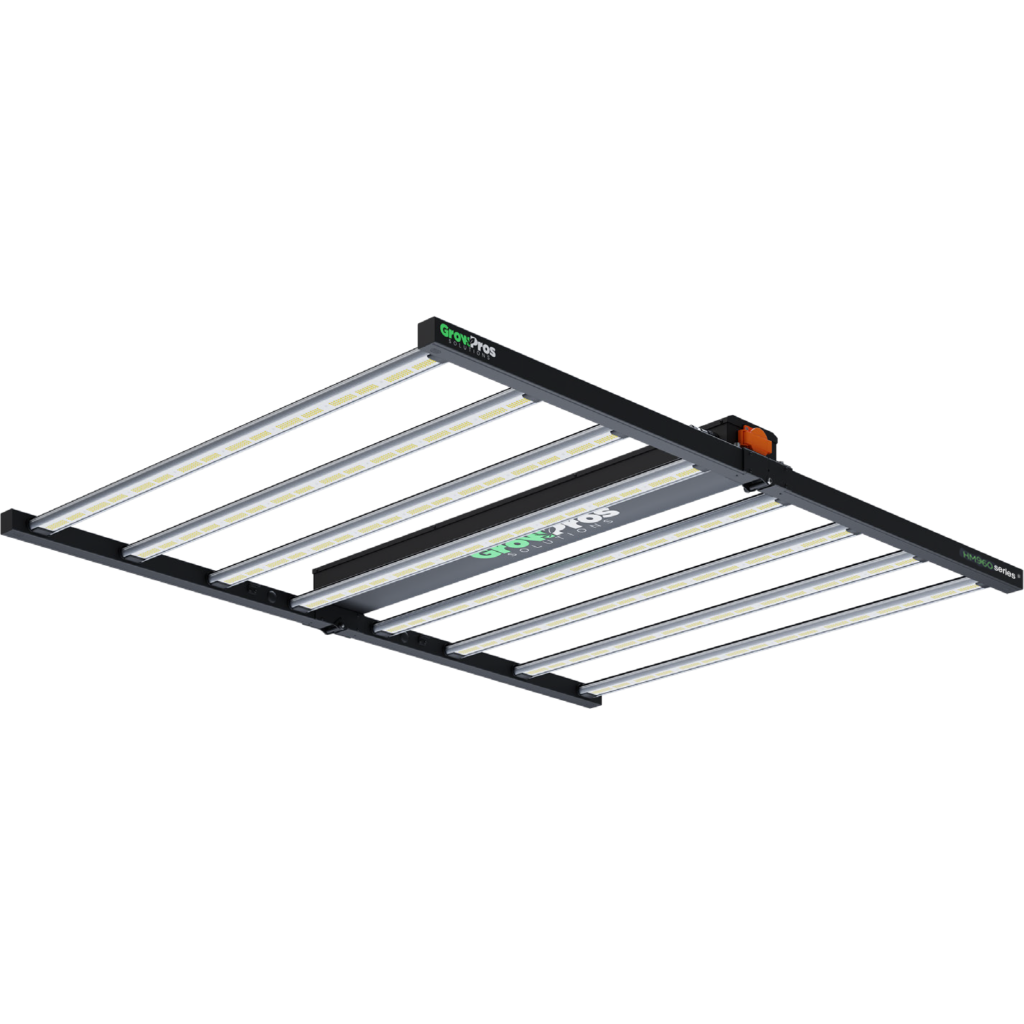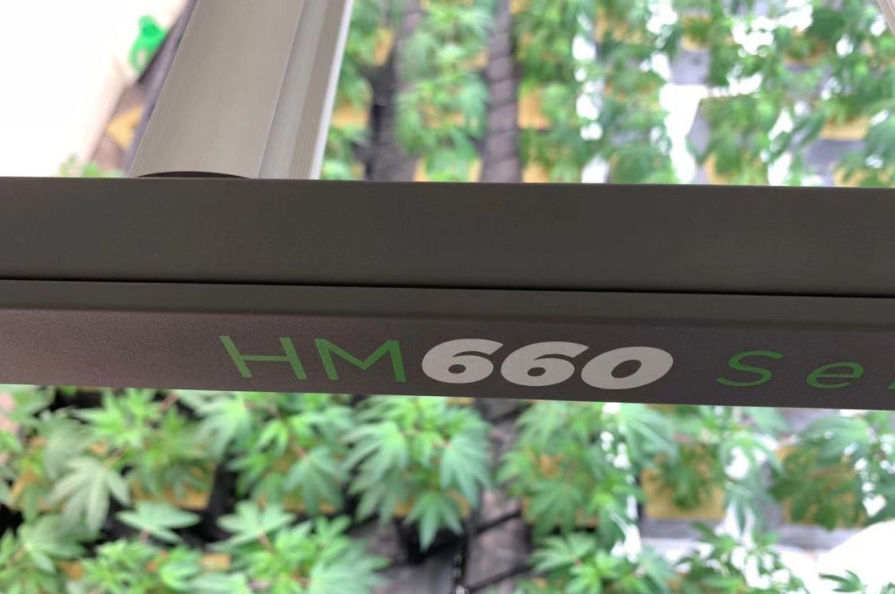
Menu
Menu

An LED, or light emitting diode, is a chip that emits light when an electric current flows through it. When the particles that carry the current combine together with the semiconductor material, light is produced. This allows more photons (light) to be produced while using less electricity than high-pressure sodium (HPS) lights. Originally, LEDs were not capable of producing the range of light that could be converted into plant ‘food.’ Only recent advancements in the color and intensity of light have allowed for the creation of full-spectrum LED grow lighting technology that can match or exceed the performance of traditional light sources.
For HPS lights, an electrical current excites the vaporized metals and gasses to produce light. Typically, HPS lights take time to heat up. A system known as a ballast is required to act as a resistor. The ballast regulates the electrical current flow through the entire circuit. Ballasts often make HPS lights bulkier than LEDs, which can come in a number of different form factors. And unlike LEDs, HPS lights can only produce one color. However, HPS lights are capable of producing high-intensity output. They are also relatively cheap to set up. On the flip side, the high intensity output generates a lot of heat, which necessitates complex ventilation setups and potentially hiked-up energy bills. HPS lamps also contain mercury, which can be toxic when and have to be disposed of properly.
Although LED technology is driving the surge of discoveries around light spectra, energy efficiency, and controls systems, LED technology costs more than traditional light sources and is more expensive to install—making the upgrading to LEDs a somewhat gradual transition. In this article, we’ll discuss why this initial higher cost of LEDs pays off over time.
Significantly More Energy Efficient and Cost-Effective
LEDs use far less energy to produce the same amount of light in comparison to HPS lights. Efficacy indicates how many photons a light emits per input watt. Specifically, efficacy compares the amount of light produced by a grow light (µmol/s) and to the amount of energy used (Joules/s).
Do LED grow lights yield more than HPS? When it comes to plant yield, the greatest proof is in the efficacy of each type of light source. LEDs are much more efficient at producing photosynthetic light than HPS lamps commonly used in indoor greenhouses. Currently, commercial double-ended HPS fixtures have an average 1.7 to 1.85 µmol while LED grow lights now climb as high as 3 µmol–which shows that LED grow lights have a 60 percent higher efficacy than traditional horticultural lamps, and this value is expected to rise in the future. So, yes, LED grow lights have the greater chance of producing higher yields than HPS grow lights.
Now, let’s look at the units of measurement. What is a mole? The correct unit of measurement for lighting crops is a mole. A mole is the North American standard for measuring light in standard light fixtures, such as troffers or downlights, which would be footcandles, or most everywhere in the world, which measures light in lux. For crops, photosynthesis is driven by a broad spectrum of light wavelengths–400 to 700 nanometers, which is referred to as PAR. The mole measures the amount of photons yielded over a square meter over a period of time, or a photoperiod. A micromole (µmol) is one millionth of a mole. Micromoles are used as the standard measurement for grow light performance because micromoles measure per second, giving an instant representation of light levels at the given moment in time, when using a light measuring tool such as a PAR sensor.
For cultivators who have limited access to electricity, this can mean having the same number of fixtures installed in a grow facility without exceeding the building’s energy limitations or compromising light intensity.
What about the cost of installing LEDs, you say? One way to offset these costs is to take advantage of local and federal rebates, on top of operational savings as evidenced through significant lower utility and maintenance costs. With the steady growth of indoor growhouses, utility companies are seeing electricity usage skyrocket, which puts immense strain on the grid. In efforts to combat that strain and to promote more energy-conscious growing techniques, power companies are offering rebates to cultivators who purchase approved high-efficiency LED grow lights rather than energy-draining traditional light sources. The rebates are not dependent upon possessing cultivation licenses or if the crop being cultivated has been legalized in that state.
Due to the energy efficiency of LEDs, grow lights using LEDs generate much less heat compared to traditional light sources. Relatively, HPS and CMH fixtures produce more heat when operating. In many environments, that excess heat needs to be removed from the growhouse to obtain optimal temperatures. This means installing and running HVAC systems, which tend to use up a considerable amount of energy, and in turn increasing operation costs. Because LED grow lights often have integral, advanced thermal management systems, and because LEDs produce much less heat, HVAC systems may operate at a lower power to maintain an optimal temperature—thus lowering costs.
Because LEDs produce significantly less heat, LED light fixtures can be installed closer to the plant canopy. In contrast, HPS/CMH grow lights can burn plants if placed too close to the canopy due to the large amount of heat they produce. Hanging lights closer to the canopy have several benefits.
One benefit is that this accommodates vertical farming, or multi-level grow operations, which allow cultivators to expand their operation while using up less square footage in their grow facility. Multi-level farming generally uses less water and may potentially produce yields up to 390 times more crops per square foot.
Another advantage to being able to place grow lights closer to the canopy is that the amount of light reaching plants is increased, eliminating the risk of light spill and allowing for focused light on certain areas of a plant canopy. (However, the coverage area of the light also decreases the closer the light is to the canopy).
Speaking in terms of PAR, or photosynthetic active radiation, let’s delve into the amount of photosynthetic light produced at certain installation heights. We can get 460-616 PPFD in a uniform spread of light across a 5-foot canopy area with a light fixture installed 20 inches away. At 15 inches away from the canopy, we can get 720-850 PPFD. At 20 inches away, the PPFD would be 1472 in the center area of the canopy and 140 at the 5-foot perimeter. In contrast, at five feet above the canopy, a grow light is 50% less effective. So, what does this mean? It means that with a quality 1000W full-spectrum grow light placed 5 feet above the canopy, it loses 50% of its output and thus efficiency.
If you notice the tips of your plants becoming burnt or yellow, that is a fair warning that your lamp is too close to the plants. Measuring PPFD (amount of photons pouring on the plant over time) can tell you how much light intensity for photosynthesis your plant is receiving at the canopy level. You may need to raise your light fixture about two inches further away to prevent leaf burns, discoloration, bleaching, or stunted growth. Many LED light fixtures are compatible with light controls that help regulate the amount of light the plant receives, before any overheating occurs.
Flower: 4’ X 4’ Area, Max: 5’ X 5’ Area
Veg: 4’ X 4’ Area, Max: 6’ X 6’ Area
RECOMMENDED SET-UP FOR COMMERCIAL INDOOR GARDEN
Vegetative stage is 75% power at about 24”-48” high
FLOWER STAGE SET-UP PER WEEK
1-2 week is 75% power at 24” high
3-6 week is 75% power at 18” high
7-8 week is 100% power at 12” high
9-10 week is 110% power at 12” high
When LEDs initially hit the market, primarily red and blue light diodes were being produced. Now, as technology is rapidly advancing, fixtures containing broad-spectrum diodes, including white diodes, are emerging on the market. One advantage of white diodes is that they are more cost-effective. The other, most significant advantage, is because of the wider spectrum of light that is capable of producing more plant-usable light for photosynthesis—which we mentioned earlier is measured in PAR. Certain wavebands of light contribute to the different stages of plant growth, which is why having a full-spectrum light fixture, now possible with LEDs, is key in contributing to the overall growth of plants and quality of yield. Studies have shown that higher ratios of blue light induce more robust root growth and a more durable structure. The vegetative stage of growth may benefit from blue light, while red light may spur growth during the flowering phase.
The vegetative stage of growth might benefit from blue light, while red light may spur growth during the flowering phase.
Another key advantage of LED technology is their longevity. Grow lights can last an average of up to 50,00 hours before light is emitted at less than 100 percent. 50,000 hours of life at 24 hours of use per day is equivalent to 5.7 years of life; 18 hours of use per day is equivalent to 7.6 years; and 12 hours of use per day is equivalent to 11.4 years. LED life is typically measured in L70 (at 50,000 hours, for example), which refers to lumen depreciation. This means that after 50,000 hours, light output will decrease by 30 percent. In comparison, HPS grow lights typically need replacement every 12 months to maintain consistent yields every season. And, the lamps in the HPS lights can die out after a mere 10 to 14 months. So, we learn that although HPS grow lights might have lower initial costs, after a few years, HPS grow lights can become more expensive than implementing LED lighting systems, once the cost of replacement lamps is considered. Now, add in the extra savings that LEDs promise by using less power, demanding less intricate cooling systems, and the availability of rebates, and LEDs emerge as the much more cost-efficient choice.
We’ve hit the main points of the benefits of LED grow lights over HPS grow lights. However, the benefits don’t stop there. More advantages include easy, hand-held control of dimming, spectrum, and scheduling, modularity, easy installation, option for daisy-chaining, IP-rated fixtures for dust- and corrosion resistance, and UL/ETL ratings for wet location rated fixtures, adjustment of distribution, durability, and ROI.

Heat from a grow light travels up. This explains why you may need to alter your HVAC or heating systems when upgrading a grow room to LEDs. Growers living in a warmer location may be more likely to need less sophisticated cooling systems for their grow room. For colder climates, more heat may need to be introduced to the grow room environment to reach optimal room temperatures. Or, in some cases, stop dehumidifiers from running, depending on your grow room set-up.
What to consider when configuring your LED grow light set-up:
In sum, choosing LED grow lights over traditional light sources has many benefits when looking to create the most dynamic, high-yielding grow light system. But it must be noted that, especially when transitioning from HPS to LEDs, for example, the benefits are not automatic. Many environmental and operational factors must be considered including growroom-specific lamp hour operation, light spectrum, intensity, installation height, light and watering schedule, CO2 supplementation, heating, roof ventilation, lamp intensity, insulation, the use of thermal screens, the climate of the location, and many more factors.Trial and error works best, and when looking for the best LED grow light for your setup, contact the Grow Pros team of experts for help in growing your business. Give us a call at 818-818-8088 or send us a message at info@wegrowpros.com.
1 Katzin D, Marcelis Leo F.M., van Mourik S. Energy savings in greenhouses by transition from high-pressure sodium to LED lighting. Applied Energy. 2021;281(116019). doi: 10.1016/j.apenergy.2020.116019.

Grow Pros Solutions is the NOW for Horticultural Science & Engineering. Grow Pros Solutions is one of the leading manufacturers of high-performance LED grow lights designed for cannabis cultivation. Our focus is to create top performing lighting solutions and fixtures that enable previously unobtainable and unthinkable results, increasing productivity from 30-60%. Our unwavering commitment to advancing technology and finding more efficient and sustainable solutions has made us a gamechanger for thousands of commercial and home growers.
Enter your email here to confirm your interest
All Rights Reserved by GrowPros Solutions